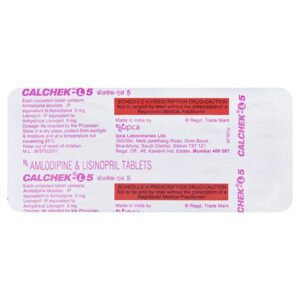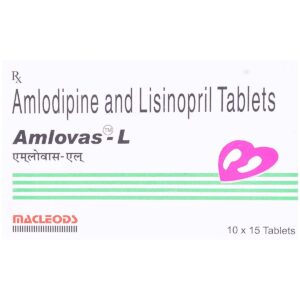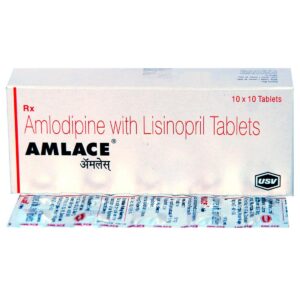AMLODIPINE + LISINOPRIL
Amlodipine: Amlodipine is a prescription medication commonly used to treat high blood pressure and certain types of chest pain known as angina. It belongs to a class of drugs called calcium channel blockers.
The main mechanism of action of amlodipine is to relax and widen the blood vessels, thereby improving blood flow and reducing blood pressure. By blocking the entry of calcium into smooth muscle cells in the blood vessels, amlodipine inhibits the contraction of these cells, leading to vasodilation.
The typical starting dose of amlodipine for adults is 5 mg once daily, with the maximum recommended dose being 10 mg once daily. It can be taken with or without food. The exact dosage may vary depending on the individual’s response and the specific condition being treated. It is important to follow the instructions provided by the healthcare professional.
Like any medication, amlodipine can cause side effects. Common side effects include dizziness, swelling in the ankles or feet, flushing, and headache. Less frequently, individuals may experience other side effects such as fatigue, nausea, abdominal pain, and palpitations. Rare but severe side effects may include liver problems, low blood pressure, and allergic reactions. It is important to inform a healthcare professional if any side effects are experienced.
Amlodipine may interact with certain medications, so it is essential to disclose all current medications to the prescribing physician. It is also important to mention any existing medical conditions, such as liver disease or heart conditions, as they may impact the use of amlodipine.
Overall, amlodipine is a widely used medication that effectively lowers blood pressure and relieves angina symptoms. However, it is crucial to follow the prescribed dose, be aware of potential side effects, and consult a healthcare professional if any concerns arise.
Lisinopril: Lisinopril is a medication primarily used for the treatment of high blood pressure (hypertension), heart failure, and to improve survival following a heart attack. It belongs to a class of drugs called angiotensin-converting enzyme (ACE) inhibitors.
The mechanism of action of lisinopril involves blocking the action of ACE, an enzyme that converts angiotensin I to angiotensin II. Angiotensin II is a hormone that causes blood vessels to narrow, leading to an increase in blood pressure. By inhibiting ACE, lisinopril relaxes the blood vessels, reducing blood pressure and improving blood flow.
The dosage of lisinopril varies depending on the condition being treated. For hypertension, the usual starting dose is 10 mg once daily, and the maintenance dose ranges from 20 to 40 mg per day. For heart failure, the starting dose is typically 2.5-5 mg daily, which may be increased gradually to a target maintenance dose of 20-40 mg per day.
Common side effects of lisinopril may include dizziness, headache, fatigue, cough, nausea, diarrhea, and low blood pressure. Less common but more serious side effects may include angioedema (swelling of the face, lips, tongue, or throat), rash, difficulty breathing, and rapid or irregular heartbeat. If any of these serious side effects occur, medical attention should be sought immediately.
It is important to note that lisinopril should generally be avoided during pregnancy, as it may cause harm to the fetus. Additionally, it may interact with other medications, so it’s crucial to inform a healthcare provider about all prescription and over-the-counter drugs, as well as any herbal supplements being taken.



